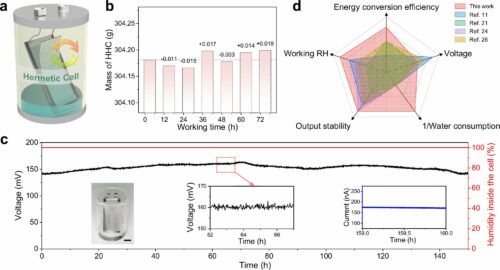Engineers from China have developed a unique hydrovoltaic cell capable of generating electricity in extreme conditions with minimal resources.

An innovative hydrovoltaic cell has been developed by engineers at the Chinese Academy of Sciences, China offering a solution to generate electricity without requiring sunlight or significant amounts of water. The research introduces the hermetic hydrovoltaic cell (HHC), an innovation designed for diverse and challenging climates.
Hydrovoltaic cells traditionally rely on water-surface interactions to generate electricity, often requiring constant sunlight and substantial water input. This dependence has limited their application to specific environments. The newly developed HHC eliminates these constraints by using ambient heat as its primary energy source, significantly broadening its usability. Its simple and cost-effective design positions it as a valuable resource for communities in arid regions, emergency response teams, and industries operating in remote areas.
Encased in a hermetically sealed structure, the HHC incorporates a double-layered wicking mechanism made of carbon black and tissue paper. By adding a small amount of water, the cell ensures continuous operation through natural capillary flow and temperature-induced water circulation. Remarkably, it can sustain power generation for up to 160 hours without replenishment.
The researchers highlighted that ambient heat, an inexhaustible resource, acts as the catalyst for energy production. They also noted that exposing the HHC to sunlight enhances its efficiency. Sunlight accelerates the water absorption process due to the black carbon layer, boosting the cell’s moisture gradient and resulting in increased electrical output.
The HHC’s versatility extends to areas with limited access to conventional electricity. Its durability and reliance on ambient heat make it suitable for supporting off-grid households, disaster relief operations, and sustainable energy initiatives in developing nations. “Such a device could prove invaluable for those facing resource constraints,” the engineers suggested.
This pioneering work underscores the sustainability of the HHC. With its low resource requirements and robust design, the cell marks a significant step forward in renewable energy technology, promising consistent power under extreme conditions










